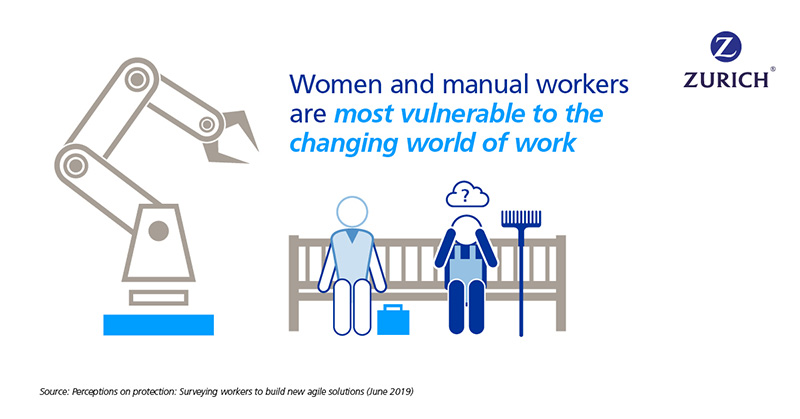A fair necessity - gender equality in an agile workforce
Future of workArticleOctober 15, 20193 min read
Contemporary and future employment patterns suggests that women are in many ways less empowered to navigate a changing workplace, according to the latest Zurich-Oxford study.
The issue of gender equality in the workplace has received renewed attention – and action – of late. Just this month, for example, Melinda Gates donated $1bn to “expanding women’s power and influence” in the US, while, in Britain, 100 businesswomen have launched the #MeTooPay campaign to eradicate the gender pay gap.
Despite these advances, Zurich’s three-year research program with Oxford University on contemporary and future employment patterns suggests that women are in many ways less empowered to navigate a changing workplace. The latest report of our findings, People protection: insights on empowering an agile workforce, was taken from a survey of 18,000 people and showed worrying patterns of gender imbalance when it comes to both flexibility and vulnerability.
Notably, only 34% of women were found to supervise other employees against nearly half of men. Every one of the 16 countries saw a greater proportion of men holding supervisory roles, while only in Switzerland were women as likely to be able to influence company decisions.
Research has shown time and again that men are less risk averse. Accordingly, our survey suggests that men are more likely to have plans to make greater changes to their working lives. Men in western countries, for example, are more prepared to move abroad to pursue a new job, while men across the surveys were 25% more likely than women to have plans to go freelance over the next year.

Men also have a greater sense of how to protect themselves with appropriate cover when going freelance – women have significantly less knowledge about all types of relevant insurance, be it for critical illness, whole of life, or income protection.
Similarly, less than a third of women indicated they had good or excellent knowledge of personal pension products against more than 40% of men. This lack of knowledge is reflected in ownership, with two in five females not holding any insurance. Gender differentiations of ownership were particularly wide in developed western economies like the UK, US, and Australia.
This is disconcerting since it leaves women more exposed, less protected and perhaps less able to fulfill their full potential.
One of the next phases of our project will focus on making recommendations for employers, policymakers and insurers as we shed further light on what the emergence of this ‘Agile Workforce Protection’ means for different economies. This research is likely to include detailed insights on the following emerging trends: employers offering their staff greater control over their workloads in order to improve retention; policymakers having to adapt social safety nets, be it through tax incentives or state-sponsorship of savings plans to protect an atypical workforce; and insurers developing new types of cover, probably through more accessible technological platforms.
But, given their differing work-life patterns and attitudes to risk, women will need particular consideration when developing these new work practices, policies, and products. Only then will empowering the more flexible workforce in the 2020s will mean empowering all employees – not only the half that have already held advantages in the workplace for centuries.





